Abstract
BACKGROUND--Arrhythmias are a common cause of morbidity after cardiac surgery. This study assessed the efficacy of prophylactic amiodarone in reducing the incidence of atrial fibrillation or flutter and ventricular arrhythmias after coronary artery surgery. METHODS--A double blind, randomised, placebo controlled trial. 60 patients received a 24 hour intravenous infusion of amiodarone (15 mg/kg started after removal of the aortic cross clamp) followed by 200 mg orally three times daily for 5 days, and 60 patients received placebo. RESULTS--6 patients (10%) in the amiodarone group and 14 (23%) in the placebo group needed treatment for arrhythmias (95% confidence interval (95% CI) for the difference between groups was 0 to 26%, p = 0.05). The incidence of supraventricular tachycardia detected clinically and requiring treatment was lower in the amiodarone group (8% amiodarone v 20% placebo, 95% CI 0 to 24%, p = 0.07). The incidence detected by 24 hour Holter monitoring was similar (17% amiodarone v 20% placebo). Untreated arrhythmias in the amiodarone group were either clinically benign and undetected (n = 3) or the ventricular response rate was slow (n = 2). Age > 60 years was a positive risk factor for the development of supraventricular tachycardia in the amiodarone group but not in the placebo group. Fewer patients had episodes of ventricular tachycardia or fibrillation recorded on Holter monitoring in the amiodarone group (15% amiodarone v 33% placebo, 95% CI 3 to 33%, p = 0.02). Bradycardia (78% amiodarone v 48% placebo, 95% CI 14% to 46%, p < 0.005) and pauses (7% amiodarone v 0% placebo) occurred in more amiodarone treated patients. Bradycardia warranted discontinuation of treatment in one patient treated with amiodarone. CONCLUSIONS--The incidence of clinically significant tachycardia was reduced by amiodarone. The ventricular response rate was slowed in supraventricular tachycardia, but the induction of bradycardia may preclude the routine use of amiodarone for prophylaxis.
Full text
PDF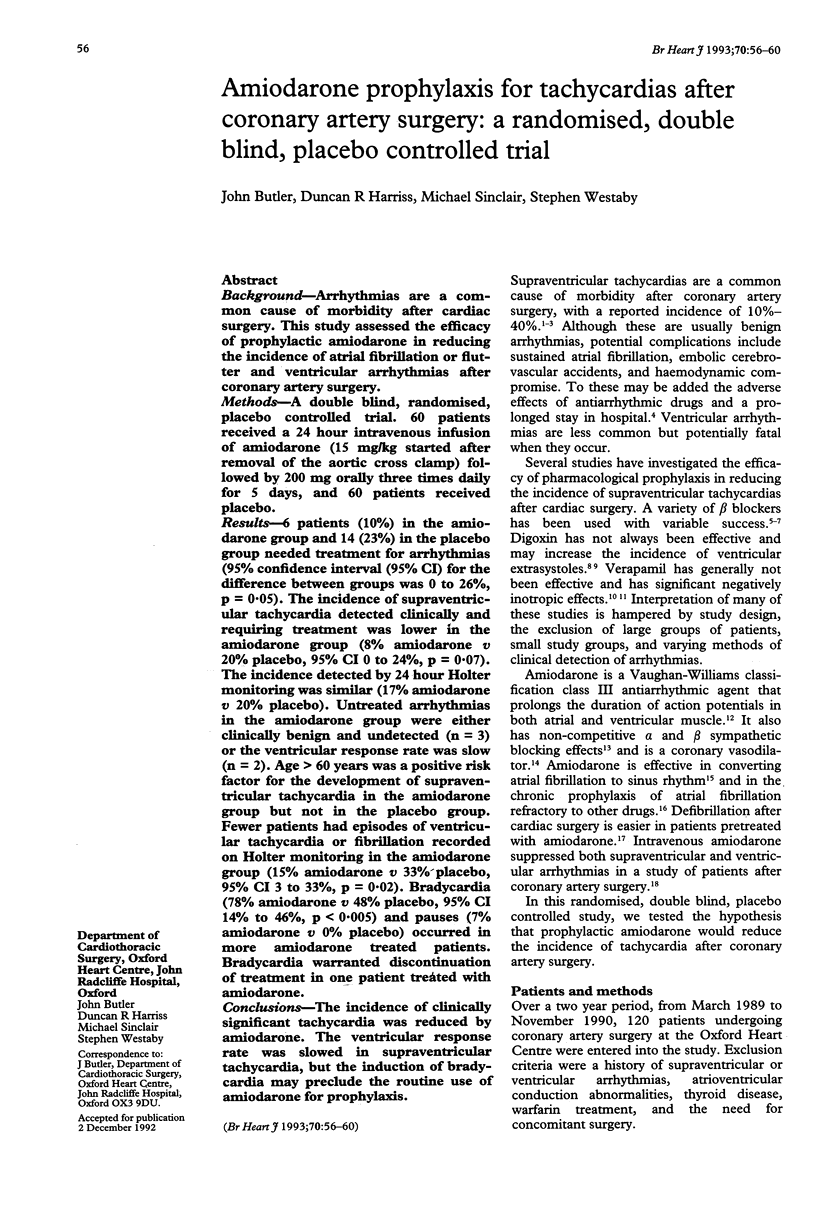
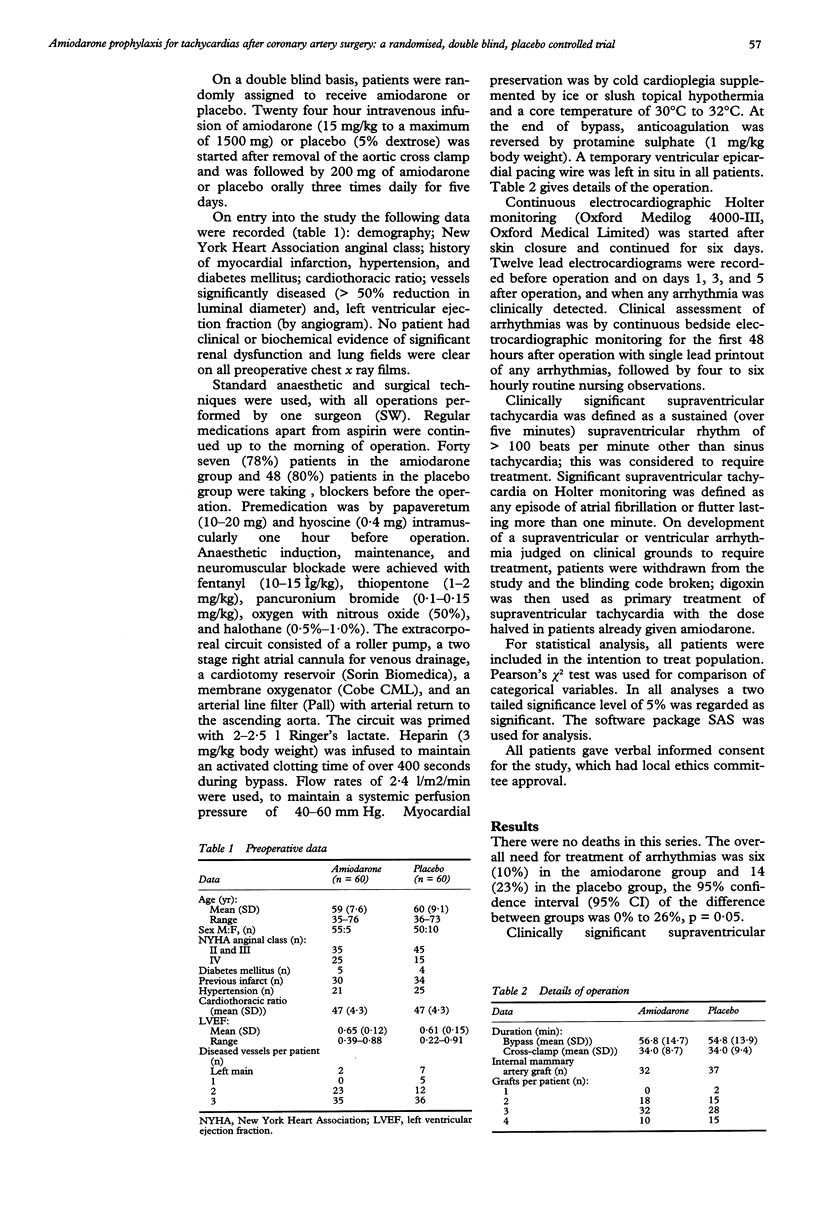
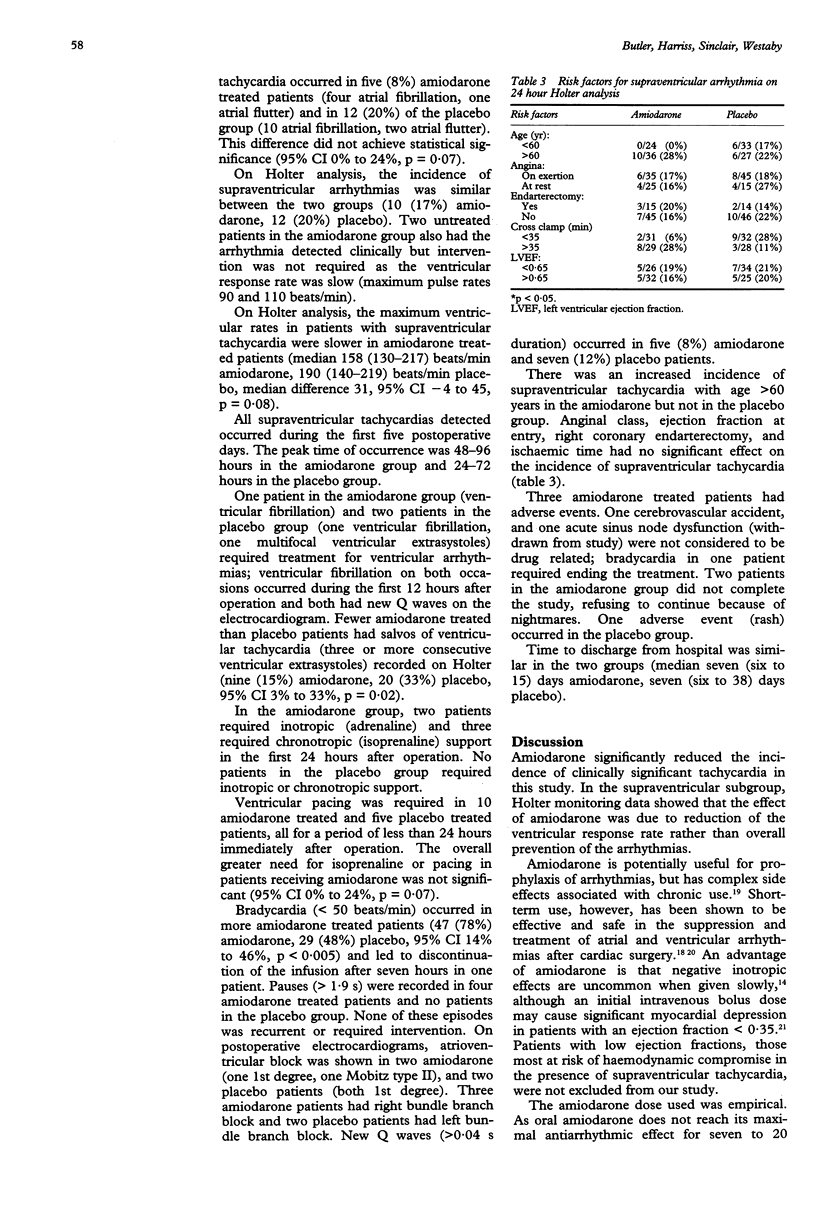
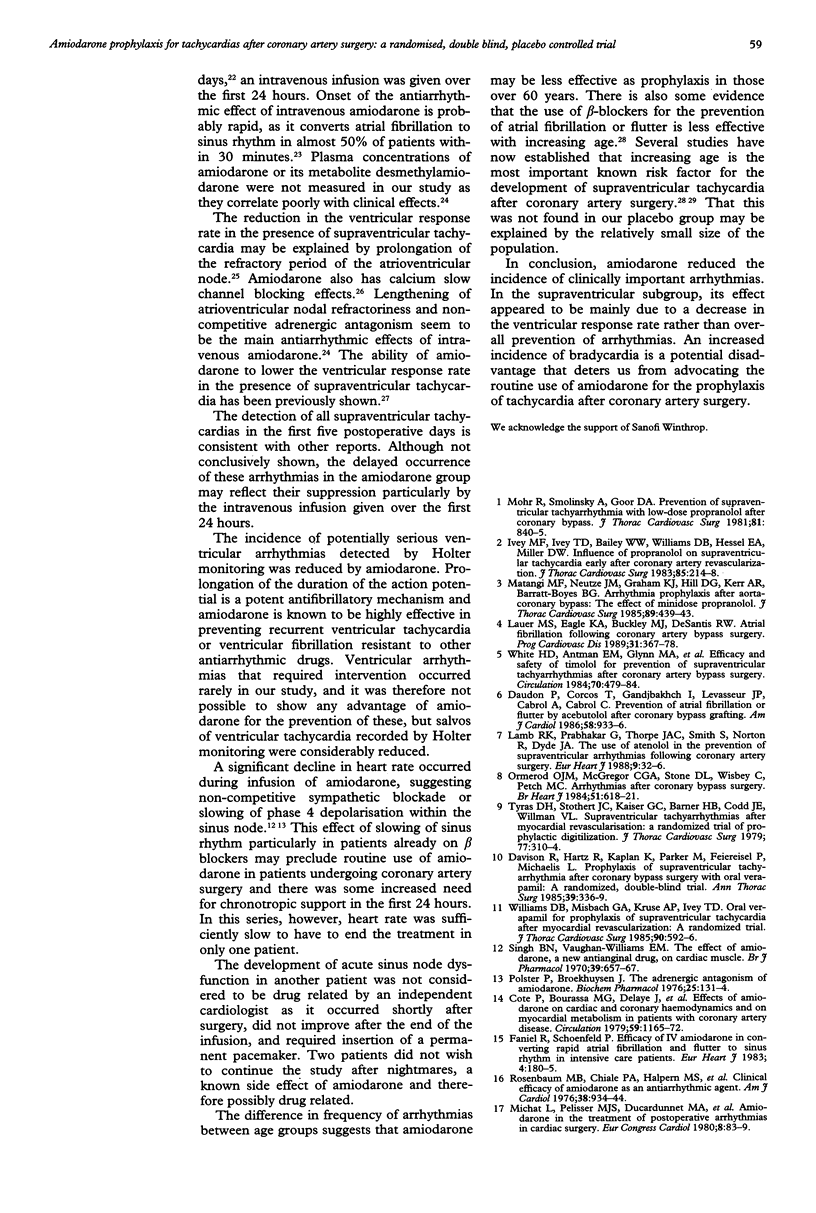
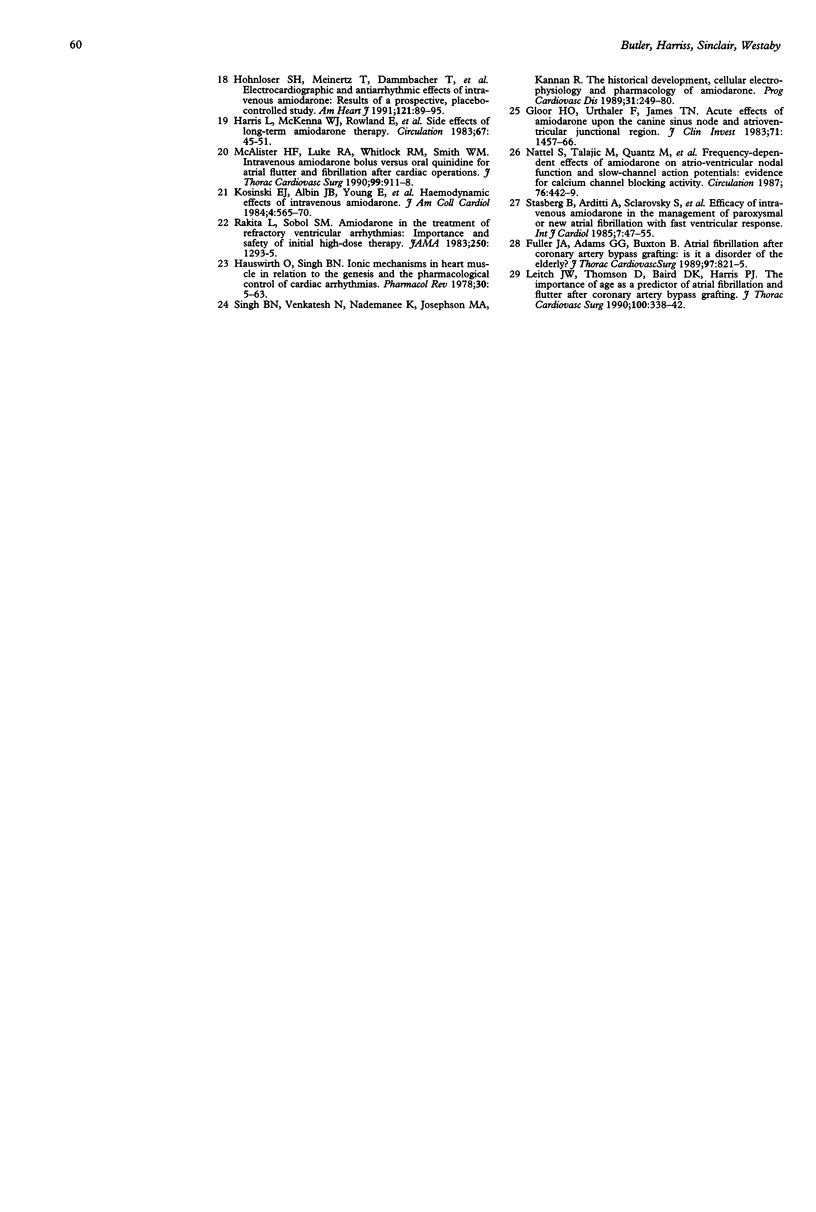
Selected References
These references are in PubMed. This may not be the complete list of references from this article.
- Côté P., Bourassa M. G., Delaye J., Janin A., Froment R., David P. Effects of amiodarone on cardiac and coronary hemodynamics and on myocardial metabolism in patients with coronary artery disease. Circulation. 1979 Jun;59(6):1165–1172. doi: 10.1161/01.cir.59.6.1165. [DOI] [PubMed] [Google Scholar]
- Daudon P., Corcos T., Gandjbakhch I., Levasseur J. P., Cabrol A., Cabrol C. Prevention of atrial fibrillation or flutter by acebutolol after coronary bypass grafting. Am J Cardiol. 1986 Nov 1;58(10):933–936. doi: 10.1016/s0002-9149(86)80014-5. [DOI] [PubMed] [Google Scholar]
- Davison R., Hartz R., Kaplan K., Parker M., Feiereisel P., Michaelis L. Prophylaxis of supraventricular tachyarrhythmia after coronary bypass surgery with oral verapamil: a randomized, double-blind trial. Ann Thorac Surg. 1985 Apr;39(4):336–339. doi: 10.1016/s0003-4975(10)62626-4. [DOI] [PubMed] [Google Scholar]
- Faniel R., Schoenfeld P. Efficacy of i.v. amiodarone in converting rapid atrial fibrillation and flutter to sinus rhythm in intensive care patients. Eur Heart J. 1983 Mar;4(3):180–185. doi: 10.1093/oxfordjournals.eurheartj.a061437. [DOI] [PubMed] [Google Scholar]
- Fuller J. A., Adams G. G., Buxton B. Atrial fibrillation after coronary artery bypass grafting. Is it a disorder of the elderly? J Thorac Cardiovasc Surg. 1989 Jun;97(6):821–825. [PubMed] [Google Scholar]
- Gloor H. O., Urthaler F., James T. N. Acute effects of amiodarone upon the canine sinus node and atrioventricular junctional region. J Clin Invest. 1983 May;71(5):1457–1466. doi: 10.1172/JCI110899. [DOI] [PMC free article] [PubMed] [Google Scholar]
- Harris L., McKenna W. J., Rowland E., Holt D. W., Storey G. C., Krikler D. M. Side effects of long-term amiodarone therapy. Circulation. 1983 Jan;67(1):45–51. doi: 10.1161/01.cir.67.1.45. [DOI] [PubMed] [Google Scholar]
- Hauswirth O., Singh B. N. Ionic mechanisms in heart muscle in relation to the genesis and the pharmacological control of cardiac arrhythmias. Pharmacol Rev. 1978 Mar;30(1):5–63. [PubMed] [Google Scholar]
- Hohnloser S. H., Meinertz T., Dammbacher T., Steiert K., Jähnchen E., Zehender M., Fraedrich G., Just H. Electrocardiographic and antiarrhythmic effects of intravenous amiodarone: results of a prospective, placebo-controlled study. Am Heart J. 1991 Jan;121(1 Pt 1):89–95. doi: 10.1016/0002-8703(91)90960-p. [DOI] [PubMed] [Google Scholar]
- Ivey M. F., Ivey T. D., Bailey W. W., Williams D. B., Hessel E. A., 2nd, Miller D. W., Jr Influence of propranolol on supraventricular tachycardia early after coronary artery revascularization. A randomized trial. J Thorac Cardiovasc Surg. 1983 Feb;85(2):214–218. [PubMed] [Google Scholar]
- Kosinski E. J., Albin J. B., Young E., Lewis S. M., LeLand O. S., Jr Hemodynamic effects of intravenous amiodarone. J Am Coll Cardiol. 1984 Sep;4(3):565–570. doi: 10.1016/s0735-1097(84)80103-5. [DOI] [PubMed] [Google Scholar]
- Lamb R. K., Prabhakar G., Thorpe J. A., Smith S., Norton R., Dyde J. A. The use of atenolol in the prevention of supraventricular arrhythmias following coronary artery surgery. Eur Heart J. 1988 Jan;9(1):32–36. [PubMed] [Google Scholar]
- Lauer M. S., Eagle K. A., Buckley M. J., DeSanctis R. W. Atrial fibrillation following coronary artery bypass surgery. Prog Cardiovasc Dis. 1989 Mar-Apr;31(5):367–378. doi: 10.1016/0033-0620(89)90031-5. [DOI] [PubMed] [Google Scholar]
- Leitch J. W., Thomson D., Baird D. K., Harris P. J. The importance of age as a predictor of atrial fibrillation and flutter after coronary artery bypass grafting. J Thorac Cardiovasc Surg. 1990 Sep;100(3):338–342. [PubMed] [Google Scholar]
- Matangi M. F., Neutze J. M., Graham K. J., Hill D. G., Kerr A. R., Barratt-Boyes B. G. Arrhythmia prophylaxis after aorta-coronary bypass. The effect of minidose propranolol. J Thorac Cardiovasc Surg. 1985 Mar;89(3):439–443. [PubMed] [Google Scholar]
- McAlister H. F., Luke R. A., Whitlock R. M., Smith W. M. Intravenous amiodarone bolus versus oral quinidine for atrial flutter and fibrillation after cardiac operations. J Thorac Cardiovasc Surg. 1990 May;99(5):911–918. [PubMed] [Google Scholar]
- Mohr R., Smolinsky A., Goor D. A. Prevention of supraventricular tachyarrhythmia with low-dose propranolol after coronary bypass. J Thorac Cardiovasc Surg. 1981 Jun;81(6):840–845. [PubMed] [Google Scholar]
- Nattel S., Talajic M., Quantz M., DeRoode M. Frequency-dependent effects of amiodarone on atrioventricular nodal function and slow-channel action potentials: evidence for calcium channel-blocking activity. Circulation. 1987 Aug;76(2):442–449. doi: 10.1161/01.cir.76.2.442. [DOI] [PubMed] [Google Scholar]
- Ormerod O. J., McGregor C. G., Stone D. L., Wisbey C., Petch M. C. Arrhythmias after coronary bypass surgery. Br Heart J. 1984 Jun;51(6):618–621. doi: 10.1136/hrt.51.6.618. [DOI] [PMC free article] [PubMed] [Google Scholar]
- Polster P., Broekhuysen J. The adrenergic antagonism of amiodarone. Biochem Pharmacol. 1976 Jan 15;25(2):131–134. doi: 10.1016/0006-2952(76)90279-3. [DOI] [PubMed] [Google Scholar]
- Rakita L., Sobol S. M. Amiodarone in the treatment of refractory ventricular arrhythmias. Importance and safety of initial high-dose therapy. JAMA. 1983 Sep 9;250(10):1293–1295. [PubMed] [Google Scholar]
- Rosenbaum M. B., Chiale P. A., Halpern M. S., Nau G. J., Przybylski J., Levi R. J., Lázzari J. O., Elizari M. V. Clinical efficacy of amiodarone as an antiarrhythmic agent. Am J Cardiol. 1976 Dec;38(7):934–944. doi: 10.1016/0002-9149(76)90807-9. [DOI] [PubMed] [Google Scholar]
- Singh B. N., Vaughan Williams E. M. The effect of amiodarone, a new anti-anginal drug, on cardiac muscle. Br J Pharmacol. 1970 Aug;39(4):657–667. doi: 10.1111/j.1476-5381.1970.tb09891.x. [DOI] [PMC free article] [PubMed] [Google Scholar]
- Singh B. N., Venkatesh N., Nademanee K., Josephson M. A., Kannan R. The historical development, cellular electrophysiology and pharmacology of amiodarone. Prog Cardiovasc Dis. 1989 Jan-Feb;31(4):249–280. doi: 10.1016/0033-0620(89)90033-9. [DOI] [PubMed] [Google Scholar]
- Strasberg B., Arditti A., Sclarovsky S., Lewin R. F., Buimovici B., Agmon J. Efficacy of intravenous amiodarone in the management of paroxysmal or new atrial fibrillation with fast ventricular response. Int J Cardiol. 1985 Jan;7(1):47–58. doi: 10.1016/0167-5273(85)90172-x. [DOI] [PubMed] [Google Scholar]
- Tyras D. H., Stothert J. C., Jr, Kaiser G. C., Barner H. B., Codd J. E., Willman V. L. Supraventricular tachyarrhythmias after myocardial revascularization: a randomized trial of prophylactic digitalization. J Thorac Cardiovasc Surg. 1979 Feb;77(2):310–314. [PubMed] [Google Scholar]
- White H. D., Antman E. M., Glynn M. A., Collins J. J., Cohn L. H., Shemin R. J., Friedman P. L. Efficacy and safety of timolol for prevention of supraventricular tachyarrhythmias after coronary artery bypass surgery. Circulation. 1984 Sep;70(3):479–484. doi: 10.1161/01.cir.70.3.479. [DOI] [PubMed] [Google Scholar]
- Williams D. B., Misbach G. A., Kruse A. P., Ivey T. D. Oral verapamil for prophylaxis of supraventricular tachycardia after myocardial revascularization. A randomized trial. J Thorac Cardiovasc Surg. 1985 Oct;90(4):592–596. [PubMed] [Google Scholar]


